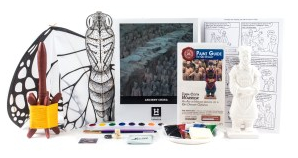History Unboxed® offers individual boxes, each focused on one history topic from ancient, medieval, or American history. Every box includes historical information, stories, and hands-on activities in a ready-to-use format. You can subscribe to receive boxes monthly, quarterly, or for an entire school year. As I will explain, these boxes are best used as supplements, although it is possible to use them as your core curriculum.
These boxes are available for three levels: ages 5 to 9, ages 10 to 15, and ages 16 and older. All of the boxes for the three levels have an eight-page “magazine” with articles, illustrations, a recommended reading list, and various other content such as recipes and maps. The majority of the articles are useful for all ages, but some are most appropriate for teens and adults.
All levels of a particular box on the same topic include the same craft(s) and other physical objects. For instance, all levels of the Missions box have a plaster replica of a tile from the Alamo mission with acrylic paints and a brush, wooden pieces and string to construct a toy similar to what children of the Missions era would have used, and a small box of salted crickets—a favorite snack of Native Americans in that era and one that's still popular around the world. The Ancient China boxes for all levels have a terracotta warrior ceramic figure with acrylic paints and a brush; a fabric kite with watercolors; tea powder to make tea; and a simple kit for making a magnetic compass with a cork, a needle, and a magnet. These craft kits include just about everything you need.
Each level has an age-appropriate coloring sheet on cardstock. You have to supply crayons, colored pencils, or markers for coloring unless you order the optional Welcome Box that includes colored pencils. (I describe the Welcome Box below.)
The boxes for the youngest level include an “open and read” sheet that makes it easy to present information on an appropriate level for this age group. Younger children are given less information, and some disturbing topics are avoided. The boxes for ages 10 to 15 add a penpal letter from Ava, a teenager who manages to time travel to each time and location. Boxes for this second level are suitable for independent study although parents might give input on the reading selections. Those using the age 16 and older box get an additional four-page booklet (instead of the penpal letter) that has some artwork images, additional articles, a recommended reading list, and an “art challenge” activity.
The optional Welcome Box has a blank timeline poster, a time capsule for students to create their own historic memento, a family tree poster, a welcome letter, and a set of colored pencils. This kit is helpful but not essential.
The publisher says you can use an entire set of boxes (Ancient, Medieval, or American, with Modern World coming next), along with books from their recommended reading lists, as your core curriculum. This option would be a unit study approach—an approach that uses a combination of resources for information and activities to focus on one topic at a time. However, there are no specific instructions for the order in which you should use items in each box, and there are no writing assignments or other methods of having students understand the content. So parents and teachers need to come up with their own way of assessing a student’s understanding, whether that be through discussion, narration, writing, or some other demonstration. Since it will take a lot of extra work to make these boxes function as complete courses, I don’t think that using it as your core curriculum for history will be practical for most families. The deficiencies I mentioned are not really an issue if you use these boxes as supplements.
Another reason that History Unboxed works better as a supplement is because coverage is spotty and selective. For example, these are the titles of the ten boxes in the Medieval series of boxes:
- Anglo-Saxons
- Byzantine Empire
- Mayans
- Islamic Empire
- Charlemagne
- Vikings
- Medieval Japan
- Mongols
- Ming Dynasty
- Mali
There are no boxes that address feudalism or the development of the Catholic Church, two major topics one would expect to see in any history of the Middle Ages. But again, using them as supplements eliminates the issue.
The perspective is secular, so these boxes can be used by government-funded programs. The authors of the written materials in the boxes try to balance their discussions on controversial topics. For example, in the Missions box, they point out that some of the Native Americans were happy living and working with the missions while others were not.
Still, the material seems to be sifted through modern-day sensibilities and concerns as evidenced by what they choose to discuss. For example, in the Missions box for young children, on the “open and read” page, the final section—titled “Science and Industry”—addresses only one topic, and an unlikely one at that. There is a single paragraph about Lady Mary Montagu, an Englishwoman who “went to Turkey and learned about a vaccination for smallpox.” No connection is made between Lady Montagu and missions. I would have expected something much more pertinent to science and Industry in relation to the missionary era since there are plenty of worthy topics. The Spanish introduced metallurgy, candle-making, plowing, and other technologies that drastically changed life for the Native American population.
These boxes have lots of interesting information and activities, but they definitely need to be used along with other resources for fuller coverage of topics.
Even though I quibble about some of the content, these boxes feature high-quality material from the printed resources to the craft projects, and they provide an easy way to make the study of history more interesting.








